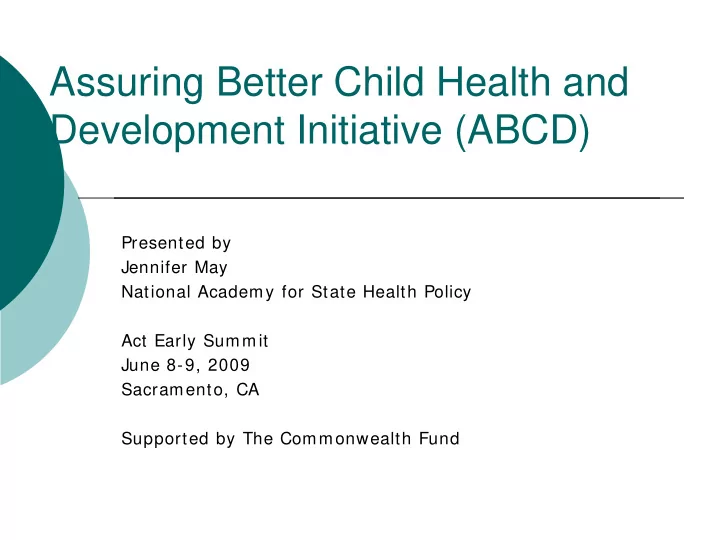

Assuring Better Child Health and Development Initiative (ABCD) Presented by Jennifer May National Academy for State Health Policy Act Early Summit June 8-9, 2009 Sacramento, CA Supported by The Commonwealth Fund
NASHP � 20 year old non-profit, non-partisan organization � Academy members � Peer-selected group of state health policy leaders � No dues—commitment to identify needs and guide work � NASHP staff � Develop, identify, and disseminate promising practices � Work informed and guided by members � Working together across states, branches and agencies to advance, accelerate and implement workable policy solutions that address major health issues
Four ABCD Projects � Three to develop models � ABCD I Consortium focused on general development (2000-2003) � ABCD II Consortium focused on social/ emotional development (2004- 2007) � ABCD III Consortium will focus on linkages (2009-2012) � One to spread a key element of the models � ABCD Screening Academy (2007-2008)
ABCD Initiative Goals � Strengthen states’ capacity to deliver care that supports young children’s healthy development � Identify and implement policy and systems changes that support the provision of preventive and early intervention care by Medicaid (and commercially insured) providers
27 ABCD States WA ME ND MT OR VT ID MN NH MA WI NY SD MI WY RI CT PA IA NJ NE NV OH UT IN DE IL MD CA CO WV VA DC KS MO KY NC TN AZ OK SC AR NM GA AL MS TX LA AK FL PR ABCD State HI
Did they succeed? � Improved policy � Supported/ promoted provider level improvements � Measured results � Built public/ private partnerships
Policy level improvements California is currently revising its CHDP Health • Assessm ent Guidelines ( HAG) to include recom m endations that the Guidelines be consistent w ith AAP Guidelines, use AAP algorithm s for developm ental and for social-em otional/ behavioral screening, and adhere to recom m ended AAP periodicity for visits. Other im portant recom m endations included screenings for ASD at 1 8 and 3 0 m onths, reducing the list of tools and sending a letter out to all CHDP providers w ith inform ation on billing Maryland’s Medicaid program began paying for up to • tw o ‘units’ of CPT 9 6 1 1 0 on the sam e date of service to allow providers to adm inister both ( 1 ) a general developm ental screening test and ( 2 ) an autism or social/ em otional screening test in the sam e visit.
Provider level improvements � I llinois’ Part C program clarified that a child can receive Early I ntervention Services if his or her parent, or other prim ary caregiver, has been diagnosed w ith a severe m ental disorder, including perinatal depression � Ohio developed and is currently im plem enting a 2 9 physician practice learning collaborative ( in conjunction w ith the local AAP chapter) designed to im prove both general developm ental and autism screening and care referral process. The ongoing collaborative w ill include collecting and analyzing data on screening im plem entation ( both qualitative and quantitative) pre/ post intervention .
Collecting and using meaningful data � All ABCD states worked toward measurement, but not all fully succeeded � Most successful in producing screening rate � 13 of 21 Screening Academy states produced pre and post measures; 3 produced pre- measure � All showed substantial increases in screening rate � Almost all produced other data to support change � ABCD II states sought to measure referral and treatment—results indicated need for ABCD III
Public/private partnerships � The I ow a legislature approved funding for the MCH agency to expand the system developed under the ABCD I I project of using EPSDT coordinators to facilitate access to follow -up services, w ith a focus on autism spectrum disorders . � Alaska ABCD’s Core Committee and Stakeholder Group are working in partnership with the EPSDT Workgroup, the Early Childhood Comprehensive Systems project, the Part C/ Early Intervention programs, and the Autism Project to implement a statewide spread strategy of structured screening in primary care.
Lessons Learned States’ efforts can improve the identification and 1. treatment of developmental delay Policy and practice improvement are (and should be) 2. tied Partnerships are critical (state agencies, physicians, 3. families, community resource agencies… .) Start small—but plan for spread 4. Performance measurement and feedback can incent 5. and support change even without new legislation or funding (but they sure help!!)
For More Information E-mail jmay@nashp.org http://abcd.nashpforums.org/ State Policy Improvements that Support Effective Identification of Children � At-Risk for Developmental Delay, Neva Kaye and Jennifer May, March 2009. Measurement to Support Effective Identification of Children at Risk for � Developmental Delay. Neva Kaye, Jennifer May, and Colleen Peck- Reuland, April 2009. State Strategies that Support Effective Identification of Children At-Risk for � Developmental Delay. Neva Kaye and Jennifer May, March 2009. Improving the Delivery of Health Care that Supports Young Children's � Health Mental Development: Update on the Accomplishments and Lessons from a Five-State Consortium. Neva Kaye and Jill Rosenthal, February 2008. Measuring and Evaluating Developmental Services: Strategies and � Lessons from the ABCD II Consortium States. Colleen Peck Reuland and Christina Bethel, December 2006. State Policy Options to Improve Delivery of Child Development Services: � Strategies from the Eight ABCD States . Neva Kaye, Jennifer May and Melinda Abrams, December 2006.
Recommend
More recommend